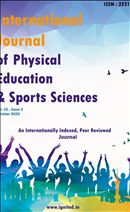Comparative Study of Physical and Physiological Variables between High and Low Performance of Men Table Tennis Players
Main Article Content
Authors
Abstract
The Purpose of the study was to compare the selected Physical and Physiological variables of High and Low Performance of Men Table Tennis Players. For the purpose of the study fifteen university (15) and fifteen non-university (15), male table tennis players were selected. Their age was ranged between 18-25 years. The selected physical and physiological variables were BMI (body mass index), flexibility, and Vital Capacity. Flexibility was measured through Sit and Reach Test, BMI was measured through a Bioelectrical Impedance analyzer and vital capacity was measured through Spirometer. The flexibility of the subjects was measured in centimeters. Body Mass Index of subjects was measured latent scores. Vital capacity of the subjects was measured in liters. Mean and standard deviation was used as descriptive statistics and an independent t-test was as a statistical technique in the study. The level of significance was set at 0.05. The result showed no significant difference in Body Mass Index and Flexibility between the university and non-university players but showed a significant difference in Vital Capacity.
Downloads
Download data is not yet available.
Article Details
Section
Articles
References
- Bemergee, A.R. (1982). Applied Exercise Physiological", Philadelphia: La and Fibiger Publication, 210. 2. Cab, D. (1968). Comparison of physical over a four year period at University of North Dakota” Research quarterly 10, pp. 9.
- Carl, E.H. (1968). A comparison of the physical fitness level attained by participants in inter- scholastic athletics and in the required physical education programme. Completed research in health, physical education recreation 10, pp. 65.
- Clarke, H.H. (1976). Application of Measurement to Health and Physical Education Englewood Cliff. N.J. Printice Hall I.N.C.
- Clarke, D.H., & Clarke, H.H. Research process in Physical education Recreation and Health", Prentice Hall, I.N.C. Englewood Cliffs, New Jersey, pp. 267.
- Kansal, Devinder K. (1996). Test and Measurement in Sports and Physical Education. D.V.S. New Delhi.
- Mouelhi Guizani S, Tenenbaum G, Bouzaouach I, Ben Kheder A, Feki Y, Bouaziz M.(2006). Information-processing under incremental levels of physical loads: comparing racquet to combat sports. J Sports Med Phys Fitness. 46(2): pp. 335-43.
- Tsolakis Ch, Kostaki E, Vagenas G. (2010). Anthropometric, flexibility, strength – power and sport specific correlates in elite fencing. Perc Mot Skills, 110: pp. 1-14.
- Verma J. Parkash. (2000). A text book of sports statistics. Venus publication.

